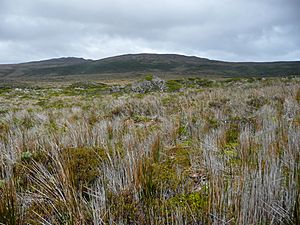Magellanic moorland facts for kids

The Magellanic moorland or Magellanic tundra (also called Tundra magallánica in Spanish) is a special kind of ecoregion found in the Patagonian islands. You can find it south of about 48° S latitude. This area gets a lot of rain. It has a unique mix of plants like scrubs, wet bogs, and small patches of forest in places that are more protected from the wind. You'll often see Cushion plants, grass-like plants, and bryophytes (like mosses) growing here.
Today, you can find small parts of Magellanic moorland much further north. For example, some are in the high areas of the Cordillera del Piuchén mountains on Chiloé Island (around 42° 22' S). Long ago, during the Llanquihue glaciation (a time when glaciers covered much of the land), the Magellanic moorland spread out more. It even reached the lower, non-glaciated parts of Chiloé Island and went even further north into the lowlands of the Chilean lake district (around 41° S).
Scientists have found it tricky to classify Magellanic moorland. This is because the type of ground, cold temperatures, and being close to the ocean all affect how it grows. Because of these things, it can sometimes be seen as a type of polar tundra (like the cold, treeless plains near the North and South Poles) or a heathland (an open area with low-growing shrubs).
Contents
Plants of the Magellanic Moorland
Many different plant groups make up the Magellanic moorland. Edmundo Pisano studied these areas and identified several types of plant communities. These include various kinds of bogs, which are very wet areas. Some bogs are dominated by Sphagnum moss, while others have different mosses or plants like sedges.
Bogs and Wet Areas
- Sphagnum bogs: These are wet areas where Sphagnum moss is the main plant.
- Magellanic sphagnum tundra
- Juncus bogs (with rush-like plants)
- Non-sphagnum moss bogs: Other types of mosses and liverworts grow here.
- Non-sphagnum moss bog
- Hepatica bogs (with liverworts)
Mires and Dwarf Shrubs
- Pulvinar mires: These are wet, spongy areas with cushion-like plants.
- Hygrophytic mire tundra (very wet)
- Montane pulvinar tundra (found in mountains)
- Bryophyte and dwarf shrub tundra (with mosses and small shrubs)
- Gramineous mires: These are wet areas where grass-like plants are common.
- Tufty sedge tundra
- Subantarctic gramineous mire
Forest Patches
In some protected spots, you can find small forests. These forests are made up of special trees that can handle the wet, windy conditions. Some of these trees include:
- Nothofagus betuloides (known as coigüe de Magallanes)
- Drimys winteri (called canelo)
- Pseudopanax laetevirens (sauco del diablo)
- Embothrium coccineum (notro)
- Maytenus magellanica (maitén)
- Pilgerodendron uviferum (ciprés de las Guaitecas)
- Tepualia stipularis (tepú)
Ground and Weather
The Soil in the Magellanic moorland is usually full of turf and other plant matter. It's often very wet and doesn't have many basic minerals. The ground underneath is made of old rocks like granitoids, schists, and ancient volcanic rocks. Any loose soil that was there before was scraped away by the Quaternary glaciations (ice ages). It's quite common to see bare rock surfaces exposed, especially in the middle of islands.
The weather where Magellanic moorland grows is typically an oceanic type. This means it's influenced by the ocean, often snowy, and has fairly steady temperatures throughout the year (isothermal). Summers are usually cool and windy. In the Köppen climate classification system, this climate is called ET, which stands for tundra climate.
See also
 In Spanish: Tundra magallánica para niños
In Spanish: Tundra magallánica para niños

